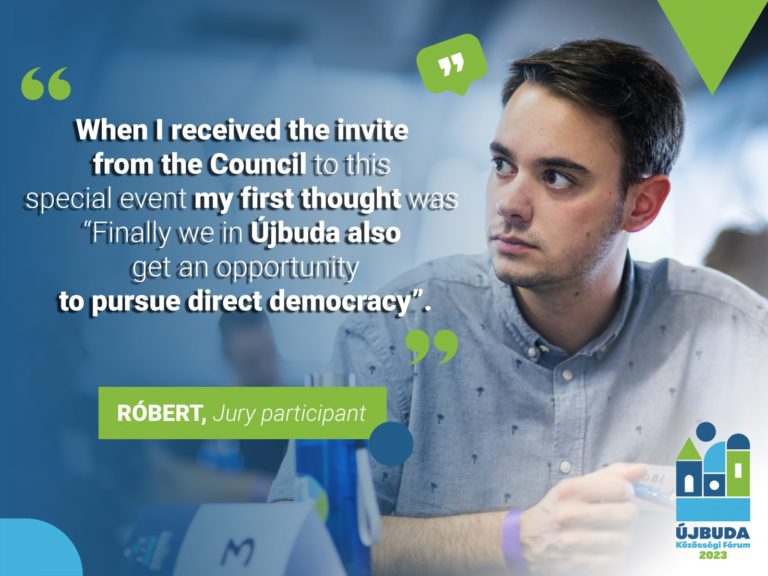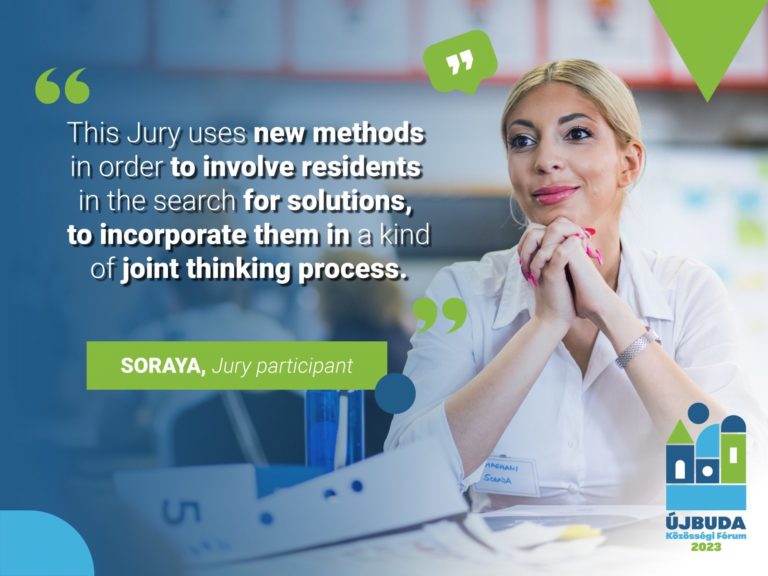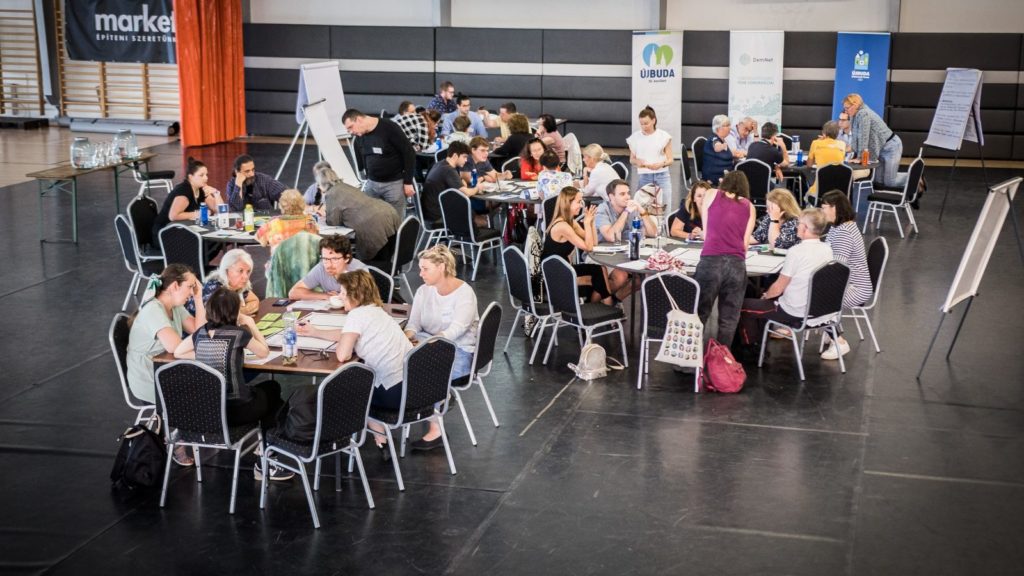New friendships, interesting discussions, great ideas – these are what defined the Citizens’ Jury which was recently held in the 11th district of Budapest (Újbuda). The aim of the three day event (June 17-18th, July 1st) was to strengthen participation in local policy making. More specifically, the 36 members of the Jury – who had been randomly selected from people living in the district – were tasked with coming up with ideas on how to ease traffic congestion in the area surrounding the Nádorliget housing estate. The problem at the heart of the chosen topic is one in need of urgent intervention since daily traffic jams and a lack of parking spaces has been a steadily growing source of stress for locals.
In Hungary deliberative democratic tools created to enhance citizens’ participation are not widely used, in fact they have only been implemented by a handful of municipalities so far (Budapest, Miskolc, Érd). There is however a growing pool of evidence, both national and international, that citizens’ juries, citizens’ assemblies and other similar events are indeed effective in improving the quality of policy making by bridging the gap between decision makers and everyday citizens.

But what actually happened in Újbuda?
Members of the Jury agreed to take part on all three days of the event which meant they would have to arrive at the venue (Gabányi László Sports Center) by 8:30 every morning and stay until the program ended around 4:30 in the afternoon. They were provided with lunch each day and snacks and refreshments throughout the event. For their time and efforts the members were also paid 12 000 HUF per day (around 31 EUR).
In the first part of the event members of the Jury listened to lectures by experts. This allowed them to gain insight into what the actual cause of the problems related to traffic were in the target area.
Bálint Dományi, architect and city planner, was the first to take the floor. He talked about how population numbers and car ownership trends have changed in the district, Budapest and Hungary in the past years. He also pointed out why the current situation can not simply be solved by creating more parking lots. Balint also brought up and analyzed the potential in other approaches to the problem.
Next, Ágnes Imrefi, urbanist and transport system developer, introduced members of the Jury to Hungarian and international best practices on how, through the meticulous planning of public and residential spaces, local environments can be transformed into becoming more sustainable and livable.
Still on the first day Barbara Emődy, the head of the Workgroup on Traffic at the Hungarian Cyclists’ Club gave a presentation on how cities evolved in connection to the development of motorized traffic. She explained how building cities where cars are the primary mode of transportation and addressing the problem of growing traffic by regularly expanding motorlanes can lead to horrendous scenarios. To underline her point she showed numerous photos and mentioned the traffic jam in 2010 in China which lasted for no less than 12 days.
At the beginning of the second day, Patrik Tóth, the head of the BKK’s (Centre for Budapest Transport) Data Analysis and Modeling Department, gave members an overview of the existing patterns in local car traffic, bicycle use and the availability and utilization of public transportation services in the area. The expert – who himself is a resident of Újbuda – pointed out that navigation apps are one element of the current problem. These apps regularly offer drivers trying to get through the district local roads which were never designed to sustain the kind of heavy traffic that is being redirected to them.
After Patrik’ presentation, Gergely Kádi, the head of the Traffic Department at the Újbuda Municipality talked about some of the plans that the district has in place to alleviate the current traffic situation.
The presentations took about 15 minutes each, following which members of the Jury discussed what they had heard in smaller groups and then were given a chance to ask questions. The Q&A session usually lasted for half an hour.
Helping the process along
It goes without saying that paying attention to lectures, interacting with new people and brainstorming for such a lengthy period of time is very hard. That is why Jury members were assisted by the members of the Hungarian Association of Facilitators who made sure that everyone got a chance to take part in the work process, was reenergized when their energy deposits started running low and helped overcome all obstacles that would prevent the Citizens’ Jury from becoming enjoyable and productive.
With the help of the facilitators, Jury members also learned about, discussed and integrated elements from the more than 80 recommendations which had previously been submitted by locals through public consultations in connection to the traffic situation in the area.
Throughout the three days we saw numeros great ideas emerge. From these members of the Jury decided which should become official recommendations on the final day by voting. We will not list all of the adopted recommendations here (these will be included in our soon to be published official report), however, we will mention a few changes that members would indeed like to see in the district:
These are…
- creating residential-resting zones in the target area while also preserving existing micromobility stations.
- extending the timing traffic lights.
- improving the visibility of the pedestrian crossing on Hauszmann Alajos Street.
- putting up signs that indicate which streets are open to exclusively target traffic and synchronizing traffic lights.
- redirecting traffic in certain areas as well as making cerian two way streets one way streets. Introducing a ban on turning for cars and creating a two way bicycle lane.
- making one way streets into two way streets and lowering the speed limit in certain places.
- expanding the existing Bubi bike-sharing system in the area and expanding the number of available bikes, especially in front of the dormitory on Dombóvári Street. The bikes should be made more comfortable and easier to handle.
- redirecting through traffic to Etele and Október 23 streets.
- introducing a 30 kilometers per hour speed limit in many places regularly checking whether this speed limit is kept by drivers.
- extending the North-South tram connection on the Buda side.
- making stops more comfortable and greener.
- having buses and trams with lowered floors and air conditioning servicing the area.
- ensuring that people living in the district would have access to reduced fee parking options. For example a parking zone could be determined based on postal codes. Residents living within this zone could park freely within the zone after purchasing a yearly card for no more than 12 000 HUF
- giving people living in the district the ability to park for free in front of public institutions within the district.
- having Újbuda join the so called Parker smart parking system.
- continuing the tree planting campaigns by the municipality but also devising a long term strategy regarding caring for these trees.
We were very happy to see that several NGOs and politicians dropped by during the meetings to get an idea of how a citizens’ jury works. In fact, on the last day three experts on participation and good governance from the European Council also visited the sports center and spoke to not only organizers and Richárd Barabás, one of the deputy mayors but also several members of the Jury.

What’s next?
We sincerely believe that those who took part in the event did not regret doing so. It was uplifting to see that many discussions that had started between members during the sessions continued over lunch and coffee.
At the same time, we would not like to create the illusion that the sole purpose of the Jury was to bring people closer to each other. The follow up of recommendations is naturally a vital part of the success of any deliberative participatory processes. As Ági, one of the members at the event aptly phrased it:
‘I am always an optimist so of course I am hopeful there is a sense to the work done by the Citizen’s Jury. Otherwise, I would not have come.’
Whether the recommendations will be taken into consideration by the policy makers is a question we do not yet have the answer to and it will take some time until we find out.
Nevertheless the fact that the Újbuda Municipality decided to partner with DemNet to organize such an event gives us reason for optimism. In fact, the district is planning to host a similar but larger scale event (a citizens’ assembly) in autumn which will see randomly selected residents of Újbuda discuss how the district could become greener.
This topic was chosen by the members of the Citizens’ Jury from four topics suggested by the Municipality. The voting was the final element of the meeting before everyone headed home to get some much deserved rest. The fact that the possible topic of a future assembly was selected in such a way has symbolic meaning. It can be viewed as an expression of hope that what had taken place in the sports center over the course of three days was not an isolated event but the first step on the road to a political culture in the district that is defined by active citizens’ participation.

